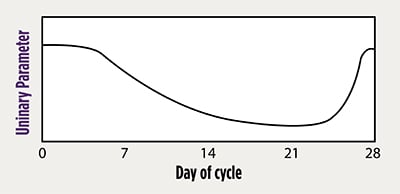If you’re preparing for the United States Medical Licensing Examination® (USMLE®) Step 1 exam, you might want to know which questions are most often missed by test-prep takers. Check out this example from Kaplan Medical, and view an expert video explanation of the answer. Also check out all posts in this series.
This month’s stumper
An investigational oral contraceptive causes less weight gain than other oral contraceptives because it contains a unique progestin that blocks mineralocorticoid receptors. One hundred consecutive female participants are instructed to take 21 days of active pills starting at Day 0 containing progestin and ethinyl estradiol, followed by seven days of placebo. Based on the data shown, which of the following parameters is most likely being measured?
A. Aldosterone
B. Angiotensin II
C. pH
D. Potassium
E. Sodium
The correct answer is D.
Kaplan Medical explains why
Since the new investigational combination drug (progestin/ethinyl estradiol) is blocking mineralocorticoid receptors, the actions of aldosterone will be antagonized during the first 21 days of the cycle. Sodium reabsorption and the secretion of potassium and hydrogen ion should be diminished, decreasing potassium and hydrogen ions in the urine. It is important to note that the graph is measuring urine potassium levels, not serum potassium levels. Since many actions of mineralocorticoids are relatively slow and because the progestin will require several days to rise to steady state levels, its effect on urine potassium excretion will not be instantaneous but will gradually increase during the drug treatment.
Why the other answers are wrong
Choice C: Since there are fewer hydrogen ions in the urine, the urinary pH would increase in the first 21 days of the cycle.
Choice E: Since sodium reabsorption would be impaired, urinary levels of sodium would be expected to increase.
Choices B and A: Urinary levels of angiotensin II and aldosterone would be expected to be elevated during the first 21 days, because suppression of the response to aldosterone decreases blood pressure. Reduced blood pressure releases the renin-angiotensin-aldosterone system from the normal negative feedback; higher plasma aldosterone causes higher urinary aldosterone excretion. The mechanism of the aldosterone response is increased renin secretion, with increased production of angiotensin II.
Angiotensin II has a very short plasma half-life (about 30 seconds); normal urinary excretion is very low, about 20 pmol per 24 hours. Increased plasma renin activity and the consequent increased production of angiotensin II would increase rather than decrease urinary angiotensin II levels. Estrogens increase hepatic production of angiotensinogen, leading to an increase in angiotensin II and aldosterone. Also, increased plasma potassium caused by decreased renal excretion is a potent stimulus for aldosterone secretion.
Tips to remember
- An antagonist at mineralocorticoid receptors will block the actions of aldosterone; if administered as a contraceptive, this occurs during the first 21 days of the menstrual cycle.
- Sodium reabsorption and potassium and hydrogen ion secretion would be diminished, decreasing potassium and hydrogen ions in the urine.
- Compensatory responses to aldosterone receptor blockers include increased plasma renin activity, angiotensin II production and aldosterone secretion.
For more prep questions on USMLE Steps 1 and 2, view other posts in this series.




